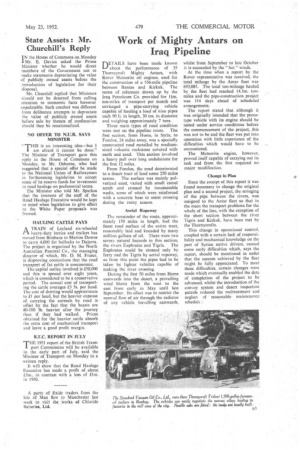Work of Mighty Antars on Iraq Pipeline
Page 37

If you've noticed an error in this article please click here to report it so we can fix it.
DETAILS have been made known about the performance of 35 Thorn ycrof t Mighty Antars, with Rover Meteorite oil engines, used for the construction of a 556-mile pipeline between Banias and Kirkuk. The terms of reference drawn up by the Iraq Petroleurn Co. provided for 14m. ton-miles of transport per month and envisaged a pipe-carrying vehicle capable of hauling a load of nine pipes each 90 ft. in length, 30 ins, in diameter and weighing approximately 7 tons.
Three main types of road condition were met on the pipeline route. The first section, from Horns, in Syria, to Forelos, 24 miles away, was a specially constructed road metalled by mediumsized volcanic rockstone covered with earth and sand. This section involved a heavy pull over long undulations for the first 12 miles.
From Forclos, the road deteriorated to a desert tract of land some 250 miles across. The surface was mainly pulverized sand, varied with small camel scrub and crossed by innumerable wadis, some of which were reinforced with a concrete base to assist crossing during the rainy season.
Aerial Ropeway The remainder of the route, approximately 150 miles in length, had the finest road surface of the entire tract, reasonably laid and kneaded by many million gallons of oil. There were two severe natural hazards in this section, the rivers Euphrates and Tigris. The Euphrates could be crossed only by ferry and the Tigris by aerial ropeway, so from this point the pipes had to be taken by lighter vehicles capable of making the river crossing.
During the first 50 miles from Horns eastwards into the • desert, a prevailing wind blows from the west to the east from early in May until late September. Its effect was to restrict the normal flow of air through the radiator of any vehicle travelling eastwards, whilst from September to late October it is succeeded by the " hot" winds.
At the time when a report by the Rover representative was received, the total mileage by the Antar fleet was 693,085. The total ton-mileage hauled by the fleet had reached 14.5n-r. tonmiles and the pipe-construction project was 114 days ahead of scheduled arrangements.
The report stated that although it Was originally intended that the prototype vehicle with its engine should be tested under service conditions before the commencement of the project, this was not to be and the fleet was put into operation with little experience of the difficulties which would have to be encountered.
The Meteorite engine, however, proved itself capable of carrying out its task and from the first required no major modification.
Change in Plan Since the receipt of this report it was found necessary to change the original plan and a second project, the stringing of the pipe between the rivers, was assigned to the Antar fleet so that in the main the transport problems for the whole of the line, with the exception of the short section between the river Tigris and Kirkuk, have been met by the Thornyerofts.
This change in operational control, coupled with a certain lack of responsibility and mechanical knowledge on the part of Syrian native drivers, caused some early difficulties which, says the report, should be mentioned in order that the success achieved by the fleet might be fully appreciated. To meet these difficulties, certain changes were made which eventually enabled the date of completion of the project to be advanced, whilst the introduction of the convoy system and desert inspection patrols reduced the maltreatment and neglect of reasonable • maintenance schedulc




















































































